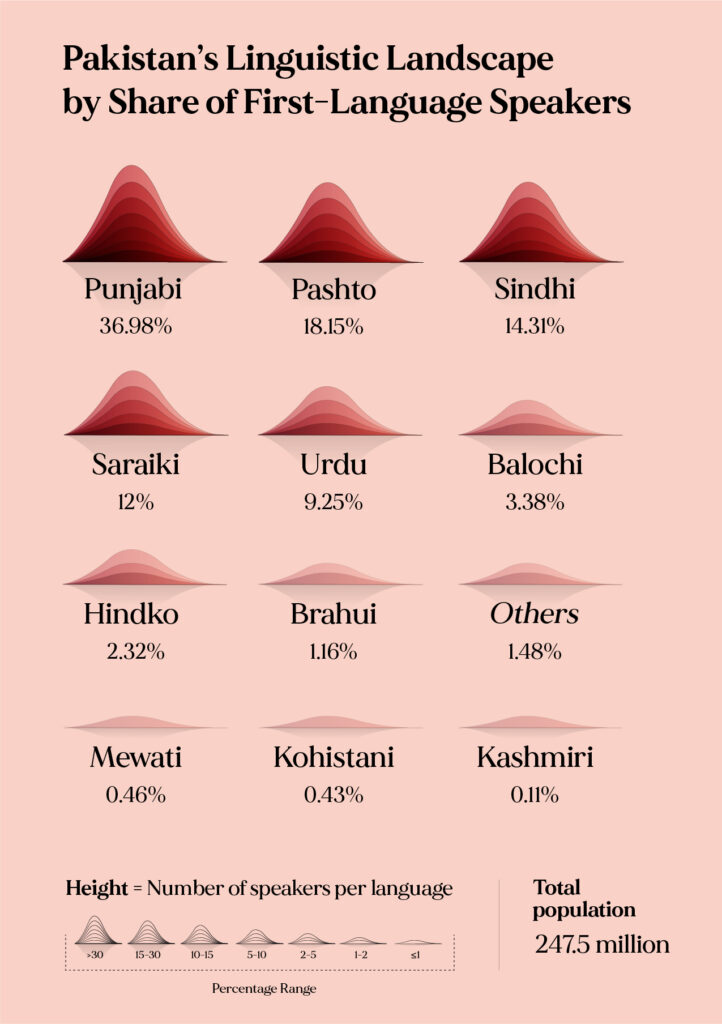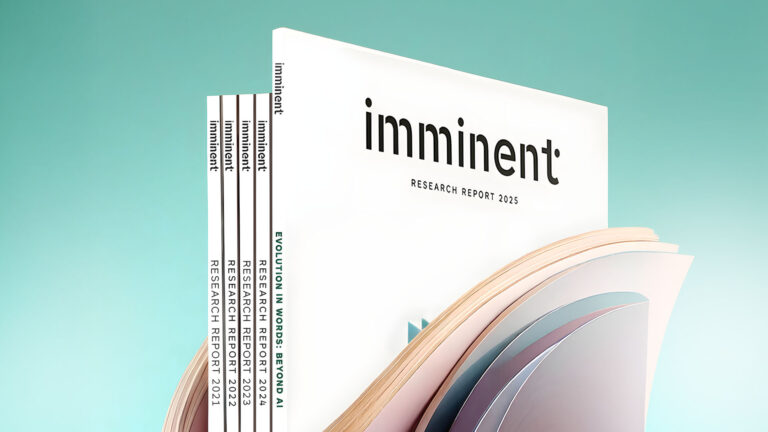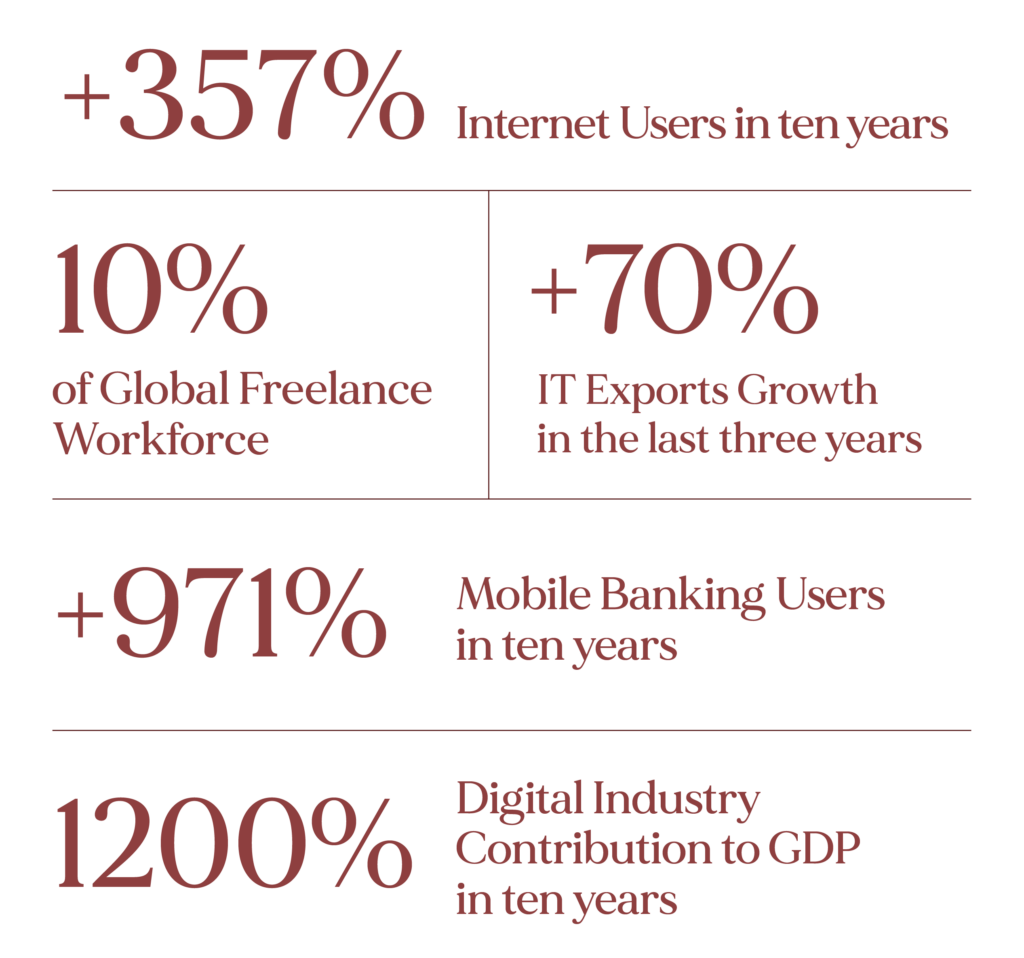Global Perspectives
May 2025
Key Statistics
- 7th largest standing army globally.
- 4th largest cotton producer.
- 8th largest textile exporter in Asia.
- 3rd largest host of Afghan refugees.
- 4th fastest-growing freelance market globally.
Imaginary Borders
In 1947, a British lawyer drew a line on a map—and 15 million people suddenly became foreigners. This historic disruption over the years led to terrorist attacks and religious conflicts, as a demonstration of the fact that some borders never truly heal. Among these, Kashmir – often dubbed the “Switzerland of Asia” has none of the Alpine nation’s peace.and it’s a border between giants.
In fact, India, a global powerhouse, is facing a rising Pakistan: 254 million people (Worldometers, 2025), a median age of 20, and a rapidly growing strategic profile. Tech-savvy, military-capable, and increasingly assertive, Pakistan is experimenting with a regional order in which India is no longer the protagonist.
Yet the so-called “bitter enemies” were part of the same colonial state for over two centuries. Everything changed when a British lawyer drew a line from an office 7,600 km away, splitting British India into Hindu-majority India and Muslim-majority Pakistan almost overnight. That line triggered one of the largest forced migrations in modern history: about 15 million people displaced, over two million killed.The partition was anything but simple. The subcontinent at the time was fragmented—divided among British, French, Portuguese, and Omani holdings, plus over 500 princely states. Through the Instrument of Accession, princely states could join either India or Pakistan—but many didn’t decide which way to turn for years. Kashmir remains the only region from British India that has never fully integrated into either country or achieved independence.
How India, Pakistan and Bangladesh were formed

Source: Al Jazeera
“Save Pakistan before saving Kashmir!”
Wedged between northern Pakistan and western India, Kashmir has always been more than disputed Wedged between northern Pakistan and western India, Kashmir has always been the epicenter of Indo-Pakistani hostility. In fact, at the time of partition, Kashmir—a Muslim-majority princely state—was given the option to join either nation. Its ruler, Maharaja Hari Singh, initially preferred independence, but when tribal militias from Pakistan attacked, he turned to India for military support. In exchange, he signed the Instrument of Accession. For Pakistan, this was betrayal. For India, it was proof of its secular, pluralist promise
Today, the region is carved in two by the Line of Control. Around six million people live under the Pakistani administration, and over 14 million under the Indian one. Meanwhile, China holds parts of the northeast. Though all three claim stakes, India and Pakistan are the primary antagonists—nuclear-armed, entrenched, and unwilling to compromise.
For Pakistan, Kashmir is a matter of identity. Punjab—its largest and most populous province—shares deep ethnic and cultural ties with it. For generations, Pakistanis have seen Kashmir’s “liberation” as a moral imperative. But in recent years, domestic concerns—terrorism, economic decline, political instability—took precedence . A and a younger generation, raised amid inflation and unrest, began to question the cost of that obsession. In intellectual circles, a new slogan emerged: “Save Pakistan before saving Kashmir.”
The conflict is often framed in religious terms, but the reasons for the struggle over Kashmir go far deeper.
- First, water. The Indus River system, Pakistan’s economic lifeline, originates in the Himalayas. Agriculture is entirely dependent on it. So are cities, industry, and the country’s water security. Losing influence in Kashmir could mean agricultural collapse, food shortages, energy instability, and economic breakdown.
- Second, infrastructure. The China-Pakistan Economic Corridor (CPEC)—Beijing’s flagship Belt and Road project—passes through the region of Gilgit-Baltistan, giving China and Pakistan both a strategic and economic stake in the region.
- Third, strategic position. Kashmir offers altitude, access, and proximity to sensitive frontiers—positioned between South Asia, the Middle East, and the Gulf. Whoever controls Kashmir controls a key geopolitical crossroads.
As of 2025, India and Pakistan possess around 170 nuclear warheads each (Al Jazeera, 2025), ranking among the top ten globally—an ever-present specter hanging over every negotiation., Kashmir is one of the most militarized regions on Earth (BBC, 2025). And far from being integrated, it’s growing harder to governThe Legacy of Partition
The 1947 partition of British India didn’t merely redraw borders—it rewrote identities, often violently.

Pakistan
Language Data Factbook
The Language Data Factbook project aims to make the localisation of your business and your cultural project easier. It provides a full overview of every country in the world, collecting linguistic, demographic, economic, cultural and social data. With an in-depth look at the linguistic heritage, it helps you to know in which languages to speak to achieve your goal.
Discover it here!The Legacy of Partition
Partition crystallized religion into the machinery of the state. In Pakistan, Hindus—once integral to the country—now make up less than 2% of the population. In India, Muslims, while still the largest minority, live under growing suspicion sinceHindu nationalism increasingly shapes media, policy, and public life. Over time, these divisions settled into class and hierarchy. In both countries, identity now dictates not just faith, but access to jobs, land, opportunity. The result: a landscape where names, languages, and affiliations determine your place in society.
And since both states weaponized the idea of the “Other,” coexistence has become a radical act. However, despite rising sectarianism, spaces of pluralism still exist. In Sindh, Sufi shrines continue to draw both Hindus and Muslims. In Karachi and Lahore, economic interdependence bridges ethnic divides Language follows suit: code-switching is common. A shopkeeper might speak Urdu, Pashto, and Punjabi in one sentence. This isn’t harmony, but it is coexistence. Improvised, fragile, deeply human.
Since both states weaponized the idea of the “Other,” coexistence has become a radical act.
The trauma of 1947 endures and yet, out of rupture has emerged resilience. The same borders that divided families now host cross-border poetry, shared music, even cricket diplomacy. Partition didn’t resolve the “Hindu-Muslim question”—it created new ones. But in the cracks between nations and narratives, people are still finding ways to exist beyond the lines.
The Secret Power of Urdu: Swallow Everything
Amid the kaleidoscope of cultures and traditions that define Pakistan, multilingualism emerges not merely as an element of identity but as a strategic means of navigating complexity. The country’s rich tapestry of 70+ languages is more than a marker of multiculturalism; it’s a functional force for cohesion. At the center of this linguistic mosaic is Urdu—a language born of convergence, embodying survival through coexistence and quiet adaptability.

Source: Pakistan Bureau Statistics
Amid the kaleidoscope of cultures and traditions that define Pakistan, multilingualism emerges not merely as an element of identity but as a strategic means of navigating complexity. The country’s rich tapestry of 70+ languages is more than a marker of multiculturalism; it’s a functional force for cohesion. At the center of this linguistic mosaic is Urdu—a language born of convergence, embodying survival through coexistence and quiet adaptability.
Although enriched by Persian and Arabic, Urdu is fundamentally an Indo-Aryan language, closely tied to Hindi in grammar and phonology. What sets them apart is their script and lexicon: Urdu draws heavily on Persian and Arabic, written in the Nastaliq script; Hindi, meanwhile, leans on Sanskrit and uses Devanagari. Moreover, what distinguishes Urdu is not just its vocabulary but its openness to linguistic cross-pollination. In fact, Urdu’s structure facilitates linguistic permeability. Its Indo-Aryan base offers familiarity to regional language speakers, while its Persian-Arabic connects it with Muslim communities. The script, adapted to suit local phonetics, further highlights its hybrid nature.
Even its origins are a story of synthesis. It evolved in the 12th century from exchanges between Persian, Arabic, and Turkish-speaking Muslim conquerors and the native Indo-Aryan population. Its very name, from the Turkish ordu (camp or army), reflects the military encampments where it first took shape.
In a country of immense linguistic variety, Urdu has managed to act not as a replacement, but as a connective tissue. Rather than merely borrowing, it absorbs—incorporating structure, idiom, and sensibility from other tongues.

Source: Medium
This fluid adaptability has allowed Urdu to become an inclusive and versatile means of communication, capable of mirroring the country’s multicultural fabric. Its ability to “swallow everything” makes it not just a bridge, but a shared cultural space.
When Pakistan gained independence in 1947, selecting Urdu as the national language was as symbolic as it was pragmatic. It had long been tied to Muslim identity and nationalism in British India, and despite being a minority language, it carried a unifying cultural resonance.
Indeed, Urdu’s reach extends far beyond Pakistan’s borders. With over 230 million speakers globally when counted alongside mutually intelligible Hindi, it ranks among the world’s most spoken languages (Ethnologue, 2025). In India alone, more than 50 million people speak Urdu. Also, significant diaspora communities in the UK, USA, Canada, the Gulf, and beyond continue to use Urdu as a means of cultural continuity.
In this multilingual reality, Urdu demonstrates how flexibility—not just of language, but of identity and imagination—can turn difference into strength. The ease with which people shift between tongues, the hybrid forms that emerge, the ways in which Urdu molds itself to context—all speak to a culture of resilience. From medieval army camps to modern global cities, Urdu has traveled far without losing its essence. In embracing the languages around it, it became a living archive of Pakistan’s pluralism. showing that a language—like a nation—can grow stronger by learning to speak in many voices.
Mera Jism Meri Marzi: My Body, My Choice
Amid the country’s plural voices, many remain unheard: for millions of women in Pakistan, equality is still a distant promise. Despite the country’s vibrant spirit, according to the World Economic Forum’s Global Gender Gap Report 2024, Pakistan stands at 145th out of 146 countries (World Economic Forum, 2024)—an alarming reminder that half its population continues to grapple with deep-rooted disparities.
This inequality‘s origins can be traced to the late 1970s, when General Zia-ul-Haq’s regime began a sweeping campaign of Islamization. Seeking to impose a unified religious identity on a diverse nation, the state infused Islamic principles into every facet of public life. But instead of creating cohesion, this agenda fractured the social fabric. The most damaging consequences fell on women, whose rights and societal roles were dramatically curtailed.
Legal reforms under Islamization codified gender-based discrimination. The Hudood Ordinances, for instance, conflated rape with adultery, shifting the burden of proof onto victims and criminalizing survivors of sexual assault. The Law of Evidence devalued women’s testimony to half that of a man’s, embedding inequality into the justice system. Under the Qisas and Diyat Ordinance, perpetrators of so-called honor killings could avoid punishment through familial forgiveness. These laws didn’t just marginalize women—they stripped them of their fundamental status as equal citizens.
The repercussions of these policies remain deeply felt today. Women face profound disparities across education, healthcare, the economy, and political life (National Report of the Status of Women in Pakistan, 2023). Female literacy hovers around 49%, compared to 70% for men. Economically, the picture is equally bleak. Women’s labor force participation lingers at just 21%, far below the global average. Only 6% of women possess a bank account, restricting their access to financial autonomy and entrenching dependence. Moreover, the prevalence of gender-based violence is chilling: 28% of women aged 15 to 49 report experiencing physical or sexual violence. Yet countless cases go unreported due to stigma, fear of retaliation, and distrust in the justice system.

Research Report 2025 is rolling out!
A journey through localization, technology, language, and research.
The ultimate resource for understanding AI's impact on human interaction. Written by a global community of multidisciplinary experts. Designed to help navigate the innovation leap driven by automatic, affordable, and reliable translation technology.
Secure your copy nowStill, in the face of these formidable barriers, Pakistani women have shown extraordinary resilience. Historic and modern movements have carved out spaces of resistance and change. Malala Yousafzai epitomizes this courage. Raised in the Swat Valley—where the Taliban banned girls’ education—Malala became an outspoken advocate for the right to learn. Surviving a Taliban assassination attempt at just 15, she rose to global prominence and became the youngest-ever Nobel Peace Prize laureate in 2014. Her story has inspired generations and shone a global spotlight on the plight of Pakistani girls.
But resistance long predates Malala. In 1981, the Women’s Action Forum (WAF) emerged as a force of defiance against General Zia’s draconian policies. Their efforts ignited a lasting feminist movement in Pakistan, proving that the struggle for rights has always been present, even when silenced. The digital age has further empowered Pakistani women, offering new avenues for activism and connection. Social media platforms have become battlegrounds where narratives are challenged and silences are broken. The global #MeToo movement resonated deeply in Pakistan, prompting women to share harrowing stories of harassment and abuse. These disclosures have shattered taboos, spotlighted perpetrators, and catalyzed vital conversations. Online platforms also serve as sanctuaries of solidarity. They allow women from vastly different regions and backgrounds to share experiences, support one another, and organize collectively. The anonymity and reach of the internet break down traditional barriers, enabling a broader, more inclusive feminist movement.
From defiant protests to digital movements, the arc of women’s resistance in Pakistan is long—and growing stronger. These acts, whether sweeping or small, are reshaping a nation’s identity. They declare, unequivocally, that Pakistani women will no longer wait for change—they are the ones creating it.
Under the Surface
Pakistan’s resilience narrative extends far beyond the social and civic realm. The same ingenuity that fuels the fight for gender equality also pulses through the veins of its economy. Amid chronic instability and deep-rooted structural flaws, the country stands at the edge of a digital transformation that may redefine not only how it grows, but who gets to benefit.
Traditionally, Pakistan’s economy has relied on agriculture, textiles, and manufacturing. Agriculture alone still employs over 36% of the labor force (Statista) and contributes nearly a fifth of the GDP (Statista). In the fertile plains of Punjab and Sindh, crops like wheat, rice, and sugarcane dominate the fields, while cotton—nicknamed “white gold”—drives a textile industry responsible for over half the country’s exports. Manufacturing, from cement and food processing to pharmaceuticals and automobiles, adds another 13% to the national output (Trading Economics, 2023).
Yet, beneath this familiar landscape lies an underexplored frontier: mining. Pakistan’s subsoil holds an estimated $6 trillion in mineral wealth, including coal, gold, copper, and chromite (Modern Diplomacy, 2025). The Reko Diq mine in Balochistan—among the largest undeveloped copper and gold reserves globally—could alone shift economic tides. But mining contributes a mere 3.2% to the country’s GDP.
Instead, the country remains mired in recurring economic crises. Inflation hit a record 37.9% in May 2023, the highest in 50 years, gutting the average citizen’s purchasing power (Business Recorder, 2023). With limited exports and mounting debt Pakistan finds itself locked in a cycle of vulnerability, turning time and again to IMF bailouts. Compounding these issues is the vast informal economy. Estimated to make up 35% of Pakistan’s GDP, the informal sector provides essential livelihoods (Imarat Institute Policy Studies, 2024)—but evades taxation and planning mechanisms. Without a reliable tax base, the government struggles to fund infrastructure, health, or education, let alone invest in innovation.
But innovation is exactly what may offer a way forward. The Digital Pakistan initiative, launched in 2019 to modernize governance, connectivity, and entrepreneurship, is at the heart of this economic shift. The proposed Digital Nation Pakistan Act aims to create a cohesive framework for digital governance, led by the National Digital Commission and Pakistan Digital Authority. The goal? Enable easier business operations, deliver public services more efficiently, and integrate more citizens into the formal economy.
Pakistan’s Digital Rise (2014–2024)

Source: Imminent
And it’s working. IT exports reached $2.6 billion in FY2022 and with over 64% of the population under 30, Pakistan has emerged as one of the world’s top freelance economies (P@sha, 2023). Special Technology Zones now offer incentives and infrastructure to tech firms—positioning Pakistan as a rising innovation hub.
One of the most striking examples of digital adaptation lies in the realm of cryptocurrency. As inflation and currency depreciation eroded trust in traditional banking, Pakistanis began turning to crypto as a hedge. This growing interest led to the formation of the Pakistan Crypto Council (PCC)—a body now working with government officials to legalize and regulate digital assets. With Pakistan ranking third globally in crypto adoption in 2021 (Federation of Pakistan Chambers of Commerce & Industry, 2021), the trend is more than speculative; it’s for survival. Cryptocurrencies offer fast, low-cost cross-border transactions, especially useful for the millions of Pakistanis abroad sending remittances home.
The future of Pakistan’s economy may hinge on its ability to fuse its traditional sectors with bold technological reform. Here, the cultural ethos of jugaad—the art of making do and innovating under pressure—becomes an economic strategy. A country burdened by volatility may be laying the groundwork for a more inclusive and agile future: one built not in spite of its constraints, but through them.
References
Infographic: How were India-Pakistan partition borders drawn? by Mohammed Haddad and Alia Chughtai (Al Jazeera)
Kashmir: Why India and Pakistan fight over it (BBC)
Why India and Pakistan Are Fighting Over Kashmir Again by Lindsay Maizland (Council on Foreign Relations)
Partition: Why was British India divided 75 years ago? (BBC)
Conflict Between India and Pakistan by the Center for Preventive Action (Council on Foreign Relations)
What’s at stake as India-Pakistan tensions rise in Kashmir by Monir Ghaedi (DW)
Kashmir: A Strategic View by Wajeeha Najam (Pakistan Horizon)
Geopolitical significance of Kashmir by Mirela Imširović (Institute for Geopolitics, Economy and Security)
Kashmir Issue: A Strategic Competition by Shahzadi Irrum (The Geopolitics)
A Historical Perspective of Urdu (National Council for Promotion of Urdu Language)
The History of the Urdu Language Together with Its Origin and Geographic Distribution by Robina Kausar, Muhammad Sarwar, Muhammad Shabbir (IJIRES, Source of Knowledge)
Urdu language (Britannica)
URDU: A Rich Mix of Multiple Languages by Areeba Writes (Medium)
National language dilemma and its potential role in nation building: Academicians’ perception in Pakistan by Tahira Begum (Sage Journals)
The ambivalent role of Urdu and English in multilingual Pakistan: a Bourdieusian study. Lang by Ashraf, H. Policy 22, 25–48 (2023)
The Islamization of Pakistan, 1979-2009 A Special Edition of Viewpoints (The Middle East Institute)
Islamization of Pakistan: A Comprehensive Overview by Sajid Mahmood Ansari (Islamic Scientific School)
Islamization in Pakistan: A Critical Analysis of Zia’s Regime by Ali Shan Shah, Muhammad Waris Abdul Basit (Global Regional Review)
The Situation of Women in Pakistan (Gender Concerns International)
National Report on The Status of Women in Pakistan, 2023 A Summary (UN Women)
Perpetuation of gender discrimination in Pakistani society: results from a scoping review and qualitative study conducted in three provinces of Pakistan by Tazeen Saeed Ali, Shahnaz Shahid Ali, Sanober Nadeem, Zahid Memon, Sajid Soofi, Falak Madhani, Yasmin Karim, Shah Mohammad & Zulfiqar Ahmed Bhutta (BMC)
A History of Women Challenging Religious Fundamentalism in Pakistan (Capire)
She was always there: Pakistani women have a long history of resistance by Wara Irfan (Dawn)
Online Feminist Resistance In Pakistan by Zoya Rehman (International Journal on Human Rights)
I volti nuovi dell’innovazione by Alberto Guidi (ISPI)
The World Bank In Pakistan (World Bank Group)
Resources and power in Pakistan by Lawrence Ziring and Shahid Javed Burki (Britannica)
Pakistan’s Mineral Economy: Unlocking Potential, Building Peace and Prosperity By Prof. Engr. Zamir Ahmed Awan (Modern Diplomacy)
Unlocking Pakistan’s Mineral Wealth: Ambitious Rhetoric Or Real Economic Transformation? By Yousuf Nazar (The Friday Times)
Pakistan and the IMF: A Cycle of Dependency and the Need for Genuine Reform by Soumya Bhomwick (Observer Research Foundation)
In Pakistan, an Economic Crisis Keeps Life on the Edge by Somaiyah Hafeez (New Lines Magazine)
Rescuing Pakistan’s economy by Aasim M. Husain (Atlantic Council)
Pakistan emerging as global tech hub with record IT exports, digital innovation (The Nation)


